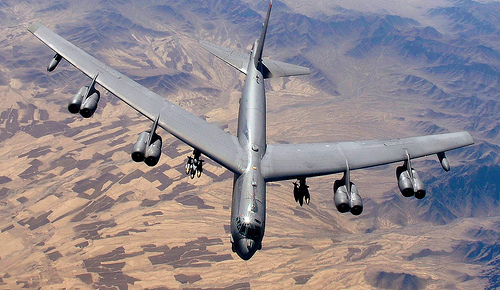Merkposten: NATO auf dem Weg zu einer neuen Nuklearstrategie?
Es ist bislang nur ein vorsichtiger Merkposten: Die Wahrnehmung in der NATO, dass Russland über einen Einsatz von Atomwaffen auf deutlich niedrigerer Schwelle als bisher nachdenke, stößt auch in der Allianz ein Nachdenken über eine geänderte Nuklearstrategie an.
Dazu zwei aktuelle Veröffentlichungen – noch alles am Anfang, aber vielleicht der Anfang von grundlegenden Veränderungen?
Center for Strategic & International Studies:
NATO’s Nuclear Policy as Part of a Revitalized Deterrence Strategy
NATO should not try to mirror Russia’s increasingly irresponsible nuclear behavior. Instead, it is time for NATO to develop a clearer nuclear declaratory policy to complement the steps underway to strengthen NATO’s conventional forces.
USNI News:
Panel: Russian Nuclear Saber Rattling Prompting NATO to Rethink Its Role
Russia’s blurring of the line between using tactical and strategic nuclear weapons in a crisis coupled with its saber-rattling statements is compelling the United States and its NATO allies to rethink their positions on deterrence, modernization and conventional forces, four national security experts told a key Senate panel. (…)
What has changed is Russia’s adoption of a strategy in spring 2014 of escalate using low-yield nuclear weapons to conclude a standoff in its favor. Putin said he had considered doing employing the tactic in earlier conflicts.
Im (heute vorgelegten) Bericht von NATO-Generalsekretär Jens Stoltenberg ist von Veränderungen noch nicht die Rede, allerdings wird auf entsprechende Übungen Russlands verwiesen:
A core element of NATO’s collective defence is deterrence, based on an appropriate mix of nuclear, conventional and missile defence capabilities. As the security environment changes, NATO adapts its policies and ensures it has the capabilities required to implement them. (…)
As part of its overall military build-up, the pace of Russia’s military manoeuvres and drills have reached levels unseen since the height of the Cold War. Over the past three years, Russia has conducted at least 18 large-scale snap exercises, some of which have involved more than 100,000 troops. These exercises include simulated nuclear attacks on NATO Allies (eg, ZAPAD) and on partners (eg, March 2013 simulated attacks on Sweden), and have been used to mask massive movements of military forces (February 2014 prior to the illegal annexation of Crimea) and to menace Russia’s neighbours.
Das Thema wird uns vermutlich demnächst noch öfter beschäftigen.
(Archivbild: B-52H Stratofortress, schwerer Bomber der U.S. Air Force, der auch für den Einsatz von Atomwaffen vorgesehen ist – U.S. Air Force photo by Master Sgt. Lance Cheung)




Über dieses Thema soll im Hintergrund des nächsten Vtdg-Min Treffen gesprochen werden. Absicht NATO ist, sich bis Warschau über weiteres Vorgehen zu verständigen und dann entsprechend zu kommunizieren. Im AA ist man nicht begeistert, das Thema soll nicht weiter bewegt werden. Ob das gelingt? Sicherlich nicht.
Gab es hier bei AG ein Memo zu den Inhalten der veränderten russischen Nuklearstrategie?
@Anubiswächter
Nein, muss ich zugeben. Geht leider nicht alles.
@T.W.:
Man kann ja nie alles erschöpfend erfassen. :-)
Interessant zu erfahren wäre, was die aktuelle russische Strategie beinhaltet, eine Beurteilung der politischen Bedeutung dieser (à la mehr Muskelspiel Putins bzw. wie ernstzunehmend), um die Überlegungen der NATO (militärisch wie politisch) einzuordnen, und um letztlich die Frage zu stellen, inwieweit die „Verheimlichung“ der deutschen Nuklearen Teilhabe damit im Zusammenhang stehen könnte, und, schließlich, welchen Standpunkt die derzeitige (deutsche) Regierung einnehmen wird (vgl. exemplarisch Koalitionsvertrag 2013).
Mal sehen, was da politisch kommen mag.
@ T.W. und Anubiswächter
Gab es hier bei AG ein Memo zu den Inhalten der veränderten russischen Nuklearstrategie?“
Zum Einstieg nützlich
„Countering Russian Nuclear Strategy In Central Europe “
http://www.cnas.org/opinion/countering-russian-nuclear-strategy-in-central-europe
Die CNAS Nukleardialektik dürfte sich mit der der Amerikanischen Nato Vertreter recht gut decken
@ alle
Wer sich schlau machen will: Hier gibt es eine deutsche Übersetzung der aktuellen Fassung der russischen Militärdoktrin.
http://www.sicherheitspolitik-dss.de/autoren/boehme/mildok14.pdf
Eine russische Fassung habe ich archiviert. Die deutsche Übersetzung kommt dem Original näher als die verfügbaren englischen Übersetzungen, die meist mit den Eigenheiten des russisch-strategisch-doktrinären Denkens nicht so gut klar kommen, wie gelernte „NVA’ler.“
Im Blick auf die US-Debatte muss bedacht werden, dass dort natürlich all das argumentiert wird, was die ab 2020 geplante Stationierung einer modernisierten Version der Nuklearbombe B61 (Mod 12) in den Teilhabe-Staaten der NATO unterstützt.
Eines dieser Argumente lautet, dass Russland – weil konventionell der NATO heute unterlegen – seine Einsatzdoktrin für Nuklearwaffen ändert und – so wie die NATO im Kalten Krieg – einen relativ frühen Ersteinsatz nuklearer Waffen ins Auge fassen könnte. Dieses Argument steht auf relativ schwachen Beinen, wenn man zum Vergleich das Vorläuferdokument heranzieht:
http://www.sicherheitspolitik-dss.de/ap/ap099000.pdf
Es gibt Themen, die man tunlichst gelassen und defensiv angehen und in der Schublade „very low profile“ belassen sollte. Die Frage nach einer neuen Nuklearstrategie der Nato, vielleicht auch noch begleitet von rhetorischem Kanonendonner, gehört m.E. dazu. Vor allem derzeit.
Viel wichtiger ist es, unsere konventionelle rasche Reaktionsfähigkeit im Bündnis konsequent zu verbessern. Da gibt es genug zu tun, was sich nuklear nicht kompensieren lässt.
@ wacaffe und @ ONA:
Besten Dank für die verlinkten Fundstellen. Ein Memo zum zeitnahen Studium ist gesetzt.
@ KeLaBe | 29. Januar 2016 – 22:09
Trumpel incoming!
Zum Glück haben wir ja eine neue Militärische Luftfahrtstrategie der Bundesregierung, die das alles „covert“!! HiHi
@KeLaBe
Vor allem der letzte Absatz: ja! Zumal im Angesicht der russischen Fähigkeit, Großverbände innnerhalb kürzester Zeit zu mobilisieren und zu verlegen.
Gibt es eigentlich öffentlich zugängliche Studien, wieviel Mann die NATO in Europa innerhalb von ein-zwei Wochen durchhaltefähig mobilisieren könnte? Das wäre doch derzeit angesichts des Zustandes europäischer Streikräfte nur unkoordiniertes Stückwerk – oder?